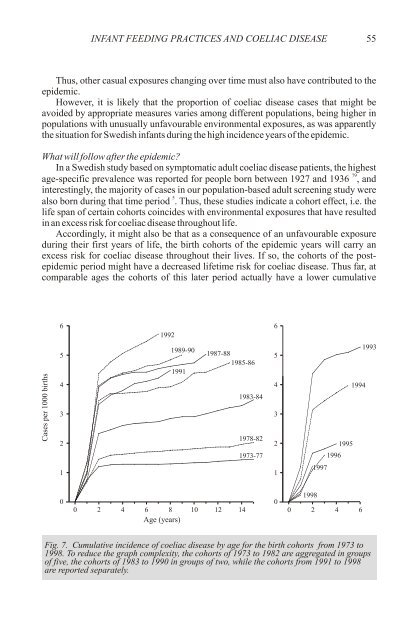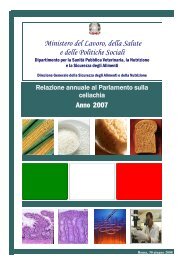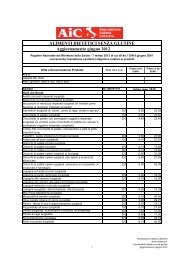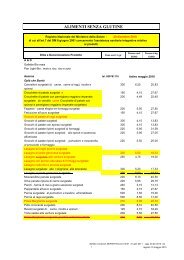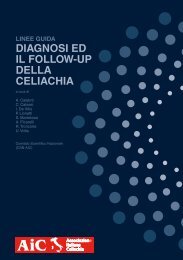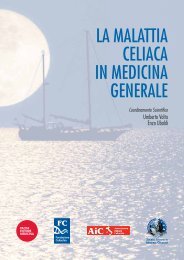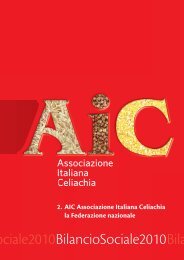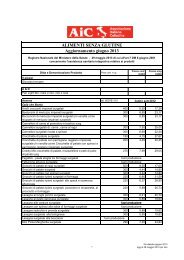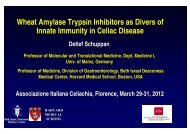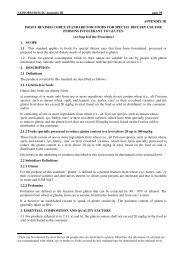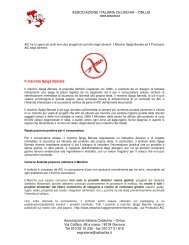primary prevention of coeliac disease - Associazione Italiana ...
primary prevention of coeliac disease - Associazione Italiana ...
primary prevention of coeliac disease - Associazione Italiana ...
Create successful ePaper yourself
Turn your PDF publications into a flip-book with our unique Google optimized e-Paper software.
INFANT FEEDING PRACTICES AND COELIAC DISEASE<br />
55<br />
Thus, other casual exposures changing over time must also have contributed to the<br />
epidemic.<br />
However, it is likely that the proportion <strong>of</strong> <strong>coeliac</strong> <strong>disease</strong> cases that might be<br />
avoided by appropriate measures varies among different populations, being higher in<br />
populations with unusually unfavourable environmental exposures, as was apparently<br />
the situation for Swedish infants during the high incidence years <strong>of</strong> the epidemic.<br />
What will follow after the epidemic?<br />
In a Swedish study based on symptomatic adult <strong>coeliac</strong> <strong>disease</strong> patients, the highest<br />
79<br />
age-specific prevalence was reported for people born between 1927 and 1936 , and<br />
interestingly, the majority <strong>of</strong> cases in our population-based adult screening study were<br />
5<br />
also born during that time period . Thus, these studies indicate a cohort effect, i.e. the<br />
life span <strong>of</strong> certain cohorts coincides with environmental exposures that have resulted<br />
in an excess risk for <strong>coeliac</strong> <strong>disease</strong> throughout life.<br />
Accordingly, it might also be that as a consequence <strong>of</strong> an unfavourable exposure<br />
during their first years <strong>of</strong> life, the birth cohorts <strong>of</strong> the epidemic years will carry an<br />
excess risk for <strong>coeliac</strong> <strong>disease</strong> throughout their lives. If so, the cohorts <strong>of</strong> the postepidemic<br />
period might have a decreased lifetime risk for <strong>coeliac</strong> <strong>disease</strong>. Thus far, at<br />
comparable ages the cohorts <strong>of</strong> this later period actually have a lower cumulative<br />
6<br />
1992<br />
6<br />
Cases per 1000 births<br />
5<br />
4<br />
3<br />
2<br />
1<br />
1989-90<br />
1991<br />
1987-88<br />
1985-86<br />
1983-84<br />
1978-82<br />
1973-77<br />
5<br />
4<br />
3<br />
2<br />
1<br />
1993<br />
1994<br />
1995<br />
1996<br />
1997<br />
0<br />
0 2 4 6 8 10 12 14<br />
Age (years)<br />
0<br />
1998<br />
0 2 4 6<br />
Fig. 7. Cumulative incidence <strong>of</strong> <strong>coeliac</strong> <strong>disease</strong> by age for the birth cohorts from 1973 to<br />
1998. To reduce the graph complexity, the cohorts <strong>of</strong> 1973 to 1982 are aggregated in groups<br />
<strong>of</strong> five, the cohorts <strong>of</strong> 1983 to 1990 in groups <strong>of</strong> two, while the cohorts from 1991 to 1998<br />
are reported separately.


